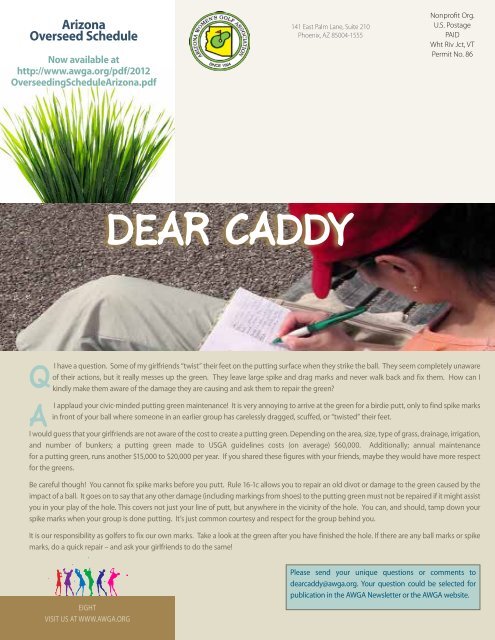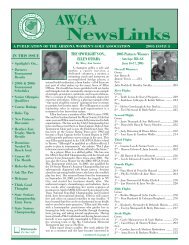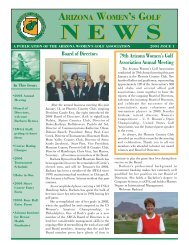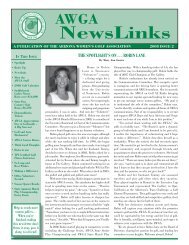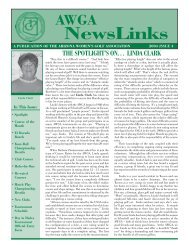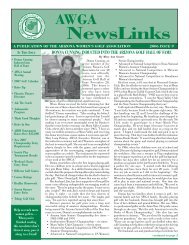Issue 6 - Arizona Womens Golf Association
Issue 6 - Arizona Womens Golf Association
Issue 6 - Arizona Womens Golf Association
Create successful ePaper yourself
Turn your PDF publications into a flip-book with our unique Google optimized e-Paper software.
<strong>Arizona</strong><br />
Overseed Schedule<br />
Now available at<br />
http://www.awga.org/pdf/2012<br />
OverseedingSchedule<strong>Arizona</strong>.pdf<br />
141 East Palm Lane, Suite 210<br />
Phoenix, AZ 85004-1555<br />
Nonprofit Org.<br />
U.S. Postage<br />
PAID<br />
Wht Riv Jct, VT<br />
Permit No. 86<br />
Dear Caddy<br />
Q<br />
A<br />
I have a question. Some of my girlfriends “twist” their feet on the putting surface when they strike the ball. They seem completely unaware<br />
of their actions, but it really messes up the green. They leave large spike and drag marks and never walk back and fix them. How can I<br />
kindly make them aware of the damage they are causing and ask them to repair the green?<br />
I applaud your civic-minded putting green maintenance! It is very annoying to arrive at the green for a birdie putt, only to find spike marks<br />
in front of your ball where someone in an earlier group has carelessly dragged, scuffed, or “twisted” their feet.<br />
I would guess that your girlfriends are not aware of the cost to create a putting green. Depending on the area, size, type of grass, drainage, irrigation,<br />
and number of bunkers; a putting green made to USGA guidelines costs (on average) $60,000. Additionally; annual maintenance<br />
for a putting green, runs another $15,000 to $20,000 per year. If you shared these figures with your friends, maybe they would have more respect<br />
for the greens.<br />
Be careful though! You cannot fix spike marks before you putt. Rule 16-1c allows you to repair an old divot or damage to the green caused by the<br />
impact of a ball. It goes on to say that any other damage (including markings from shoes) to the putting green must not be repaired if it might assist<br />
you in your play of the hole. This covers not just your line of putt, but anywhere in the vicinity of the hole. You can, and should, tamp down your<br />
spike marks when your group is done putting. It’s just common courtesy and respect for the group behind you.<br />
It is our responsibility as golfers to fix our own marks. Take a look at the green after you have finished the hole. If there are any ball marks or spike<br />
marks, do a quick repair – and ask your girlfriends to do the same!<br />
EIGHT<br />
visit us at www.awga.org<br />
Please send your unique questions or comments to<br />
dearcaddy@awga.org. Your question could be selected for<br />
publication in the AWGA Newsletter or the AWGA website.


